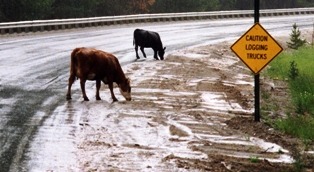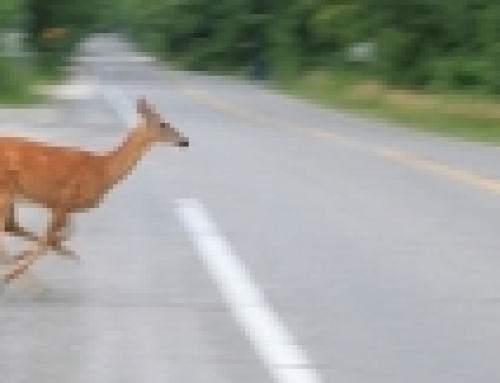 Hunting with Motorcycles
Hunting with Motorcycles
By Traveler
This is the time of the year that winter weather changes to spring and motorcyclists take to the road in large numbers. Animals small and large take to the roads also and become an increasing hazard again until late fall. You will find that taking the time to do your pre-ride risk assessment, be alert to your surroundings, and practicing avoidance techniques, will pay off in safe cycling throughout the year.
Not only does an experienced rider look at the weather, cycle, and the route but, hazards that may be encountered as well, such as the animals the rider could run into.
Below are some basic tips for avoiding the animal that could injure or kill you while cruising through the countryside
– First and foremost you should consider wearing approved protective gear; helmet (Full-face is the best), gloves, long pants, long-sleeve shirt/jacket (day), retro reflective upper-outer garment (night), over the ankle shoes (leather boots are the best), and any other ballistic type outer wear that protects your body.
– Watch for areas along the road where the surrounding land is wet or a brook crosses under the road. These are usually areas used by animals for crossing but may not have transportation departments animal crossing signs.
– Heed animal crossing signs. Around here we have deer-crossing signs. In many other areas you have Moose, Elk, Free – Range Cattle, Horse, Turtle, Raccoon and, I have even seen Frog – Crossing signs. Turn up your alertness, slow down, use your high beam, and cover the brakes when you’re in areas like this. By the way, flashing your headlights and revving your engine, may break the spell that seems to cause animals to freeze.
– Additionally, good, powerful driving lights are worth their weight in gold on a deserted road at night. They also increase your visibility to other vehicles. Alternatively, fit your bike with high wattage (100-watt high-beam) High intensity Discharge (HID) headlight bulbs.
– If you are driving at night and see the oncoming headlights “twinkle”, that is probably an animal’s eyes reflecting your headlight beams. They are rarely alone and may be with young. Slow down and keep your eyes open, brakes covered, and make noise (exhaust pipes, horn, obscenities, etc).
– During the spring time, animals may congregate along the sides of roads to lick the salt applied during the winter months to control iced roads.
– “S.E.E.”- Search, Evaluate, and Execute…a simple but powerful strategy taught in the Basic Riders Course (BRC). It should be employed as far in front of the rider as visibly possible when riding in areas where animals are common. The strategy will allow more time to stop if an animal is spotted. Stopping is an appropriate maneuver to avoid an animal strike. Once the animal is spotted and the motorcycle comes to a stop the rider can proceed very slowly with caution unless it’s an animal that can eat you.
– Small animal motorcycle collisions with raccoons, armadillos, dogs and the like can also be deadly. A fast-moving motorcycle with the brakes locked is a recipe for disaster. A glancing hit can veer a motorcycle off the road and out of control. These animals are low and have a round body structure that doesn’t crush easily, causing the body to roll under the motorcycle.
– The proper rider position in this case is important. The rider should ride across a small animal as you would ride over a small fixed obstacle; straight up, slow down, approach at a 90-degree angle if possible, weight shifted to the rear and slightly off the seat, strong grip on handlebars, knees squeezing the tank. Shift weight to the rear by slightly rolling on the throttle just before the front wheel makes contact with the small obstacle. Rolling on the throttle reduces the weight on the front wheel helping climb over the obstacle. Upon contact with the obstacle roll off the throttle immediately so the rear wheel is not under power when it strikes the object.
Avoidance techniques, well executed are absolutely invaluable to survival in emergency situations. If, the first time you ever have to swerve your motorcycle, or the first time you have to do an emergency stop is to avoid a dangerous encounter you are already at a loss.
Swerving. When it is safe, and you have the opportunity to practice, try executing swerves to avoid an obstacle. An opportune time is when you are safely changing lanes. Occasionally, make your lane change swiftly and aggressively so you’ll know what the bike feels like and you’ll become proficient at it if, and when, you ever have to do it. If you do not become proficient at swerving, you have a great chance of joining that group of fallen riders whose excuse is…”I decided to lay it down.” What they’re really saying is, “I didn’t know how to swerve.”
Braking. We can talk about this ad infinitum. There is an overwhelming amount of information available on HOW to brake in an emergency but, it’s like foreplay. You ain’t gonna become good at it by talking about it. Ideally, you should start practicing emergency braking in a safe, no traffic area like a large parking lot. Practice braking at increasing speeds until you are comfortable with hard, aggressive braking at speeds that you normally ride at. Once you are comfortable solo, practice braking with your co rider. Do not practice emergency braking when riding in a group. Practice alone.
Combining. There are likely situations where you may have to emergency brake and swerve or vice versa. Be alert to any traffic behind you. You may have to combine emergency braking with swerving to be able to slow enough to safely swerve or to avoid traffic approaching behind you. It won’t do you much good to only be comfortable and proficient at braking or swerving. You must master both techniques.
Encounters with animals are common where bikers like to ride, in the countryside and on the twisties. There is no, single, perfect, fail – safe way of avoiding them.
Extra vigilance and preparedness, knowing when and where to expect large animals, slowing down, being proficient at emergency braking and swerving are your best bets for avoiding and mitigating the dangers from animals. Far too often, with animal encounters, there are two kinds of road kill…the rider and the animal. Stay alert!
(To see the entire article with more pics, CLICK HERE to read the May issue of ROAR)





